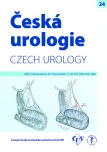Bulbar urethral reconstruction after extensive inflammatory abscess‑forming process in the perineal region due to an underlying foreign body
Authors:
Pavel Drlík 1,2; Milan Čermák 3
Authors‘ workplace:
Urologické oddělení, ÚVN Praha
1; Urologická klinika, 1. LF UK a VFN, Praha
2; Urologické oddělení, Oblastní nemocnice Kladno
3
Published in:
Ces Urol 2020; 24(2): 90-93
Category:
Video
Overview
Introduction: Injuries to the bulbar urethra are often isolated. They account for approximately 10% of lower urinary tract injuries and 35% of all injuries to the urethra. They typically include various nonpenetrating straddle injuries (falls astride or kicks). However, injuries due to instrumental manipulation (catheterization, endoscopic procedures) are the most common occurrence. Urethral injury is also encountered in the case of foreign body insertion for the purpose of masturbation. The vast majority of such cases result in penile urethral injury. When foreign bodies are inserted into the urethra, there is a serious risk of inflammatory complications which are much more severe if the bulbar segment is involved. If a foreign body remains in the bulb, the development of an abscess-forming process is very likely. The video presents the treatment and reconstruction of the urethra following an extensive abscess-forming process due to an underlying foreign body (a fish hook) inserted into the bulbar urethra by the patient.
Case presentation: The video presents a case of a 75-year-old man who inserted a fish hook into his bulbar urethra for the purpose of masturbation. Initially, he was examined repeatedly for symptoms of dysuria and treated by his general practitioner for the diagnosis of lower urinary tract infection. He received common anti-inflammatory medications (cotrimoxazole, nitrofurantoin). However, he denied the presence of a foreign body. Fourteen days later, he presented with exhaustion and fever to the emergency department of our hospital. Because of scrotal and left inguinal swelling, orchiepididymitis was suspected. For this reason, a urologist was called by the emergency physician. Since the local finding was significant, the urologist ordered a CT scan of the abdomen, little pelvis, and genitalia. The CT scan showed an extensive abscess-forming process in the perineum, including a foreign body (a fish hook). It was only the severity of his condition and the clear CT evidence that made the patient confess to having inserted the foreign body. Subsequently, a decision was made to perform open surgical exploration with abscess drainage under antibiotic cover. During the procedure, a fish hook was removed endoscopically, and a partial reconstruction of the bulbar urethra was performed and perineal urethrostomy was created. Urinary diversion was achieved by an indwelling 20F urinary catheter and vesicostomy. The size of the indwelling catheter greater than the usual 16F was chosen due to concerns about considerable inflammatory tissue retraction during healing. Next, the important phase of nursing care with frequent dressing changes and irrigation followed. Betadine solutions and silver-containing agents were used for irrigation. Concurrently, the patient took antibiotics based on sensitivity testing of the collected inflammatory abscess material. First, 1 g of co-amoxiclav was administered intravenously which, after one week, was switched to oral form. The duration of targeted antibiotic therapy was 14 days. For another 14 days, the patient received oral cotrimoxazole al forte with a daily dosage of 1-0-1 tablets. In three months, after the inflammatory focus had been healed, bulbar urethral reconstruction was performed using the Johanson technique. Following the procedure, the patient again received a 14-day course of oral cotrimoxazole al forte with a daily dosage of 1-0-1 tablets.
Results: Six weeks after the reconstruction phase, the indwelling urinary catheter and vesicostomy were removed. The indwelling urinary catheter was left in place longer than is usual in common reconstructive procedures on the urethra due to some concern about the success of healing. Typically, an indwelling urinary catheter is left in situ for three to four weeks. Voiding cystourethrography revealed a free and healed urethra. The patient remained under surveillance care. Four months after the procedure, the patient was satisfied and able to urinate freely, with an 18F urethral calibration and a peak flow rate on uroflowmetry of 23.1 mL/s. At one-year follow-up, the patient continued to be symptom-free and satisfied. Urethral calibration was free for 20F and the peak flow rate on uroflowmetry was 21.4 mL/s.
Conclusion: The key to successful management of severe inflammatory processes involving the bulbar urethra is correct timing of the individual steps which include surgical exploration, abscess drainage, creation of perineostomy, and urinary diversion with an indwelling urinary catheter and vesicostomy. Urethral reconstruction should be performed with a delay of at least three months, after infectious and inflammatory processes have healed completely. Thorough nursing care is an integral component that will aid in achieving the desired result.
Keywords:
foreign body – voiding cystourethrography – bulbar urethral reconstruction.
Labels
Paediatric urologist Nephrology UrologyArticle was published in
Czech Urology

2020 Issue 2
Most read in this issue
- Renal tumor biopsy – indications, technique, results
- Examination of circulating tumor cells in renal carcinoma
- Objemný cystický lymfangiom levé nadledviny – diferenciálně diagnostický omyl
- Natural healing process after partial glans excision while using novel haemostatic „VerisetTM patch“: description of the technique and initial surgeon’s perspective
